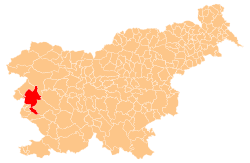Solkan Bridge


The Solkan Bridge (Slovene: Solkanski most, Italian: Ponte di Salcano) is a 219.7-metre (721 ft) arch bridge over the Soča River near Nova Gorica in western Slovenia (by railway terminology it is a viaduct). With an arch span of 85 metres (279 ft), it is the longest stone bridge among train bridges built of stone blocks. It holds the record as later construction technology used reinforced concrete to build bridges.[1] It was originally built in the time of the Secession, between 1900 and 1905, and officially opened in 1906.[2]
Description
The bridge was designed by the architect Rudolf Jaussner and engineer Leopold Örley, initially with an 80 m stone arch. The bridge was built by the Viennese construction company Brüder Redlich und Berger between 1904 and 1905. In the spring of 1904 the builders had to change the project because of the light soil and increased the arch to 85 meters.[3] It is built of 4,533 stone blocks.
On July 19, 1906, the railway from Jesenice to Gorizia was inaugurated (the Austrian heir Franz Ferdinand travelled across the bridge).
In August 1916, during the First World War, Austrian soldiers destroyed the bridge (using 930 kg Ecrasite) as they left Solkan to prevent the invading forces from using it. After the war the Italians first built a steel construction where the bridge once stood and in April 1925 started to build a new bridge, which was finished in 1927. This bridge was very similar to the first one, with the exception of having only four sub-arches instead of the original five.
During the Second World War the bridge suffered only minimal damage from bomb attacks. On August 10, 1944, bombs didn't hit the bridge; on March 15, 1945, a bomb having hit the bridge didn't explode.
Literature
- Gorazd Humar: Kamniti velikan na Soči. Branko, Nova Gorica 1996, ISBN 961-6079-30-1.
- Gorazd Humar, Bogdan Kladnik: Slovenski Mostovi: Bridges of Slovenia. Teil 2: Štajerska, Dolenjska, Gorenjska, Prekmurje. Zaklad, Ljubljana 2002, ISBN 961-6266-12-8.
- Eduard Jordan (2013): Der Eisbahnviadukt von Solkan/Salcano
- Walther Schaumann: Die Bahnen zwischen Ortler und Isonzo 1914 - 1918. Vom Friedensfahrplan zur Kriegsfahrordnung. Bohmann Verlag, Wien 1991.
References
- ↑ source Via Transalpina, published by Museum of Slovene Railway
- ↑ Gorazd Humar (September 2001). "World Famous Arch Bridges in Slovenia". In Charles Abdunur. Arch'01: troisième Conférence internationale sur les ponts en arc Paris: (in English and French). Paris: Presses des Ponts. pp. 121–124. ISBN 2-85978-347-4.
- ↑ Nebojša Tomašević (1982), Treasures of Yugoslavia: an encyclopedic touring guide, Yugoslaviapublic, p. 87, OCLC 10184316
External links
 Media related to Solkan Bridge at Wikimedia Commons
Media related to Solkan Bridge at Wikimedia Commons
Coordinates: 45°58′44″N 13°39′07″E / 45.978981°N 13.651822°E
